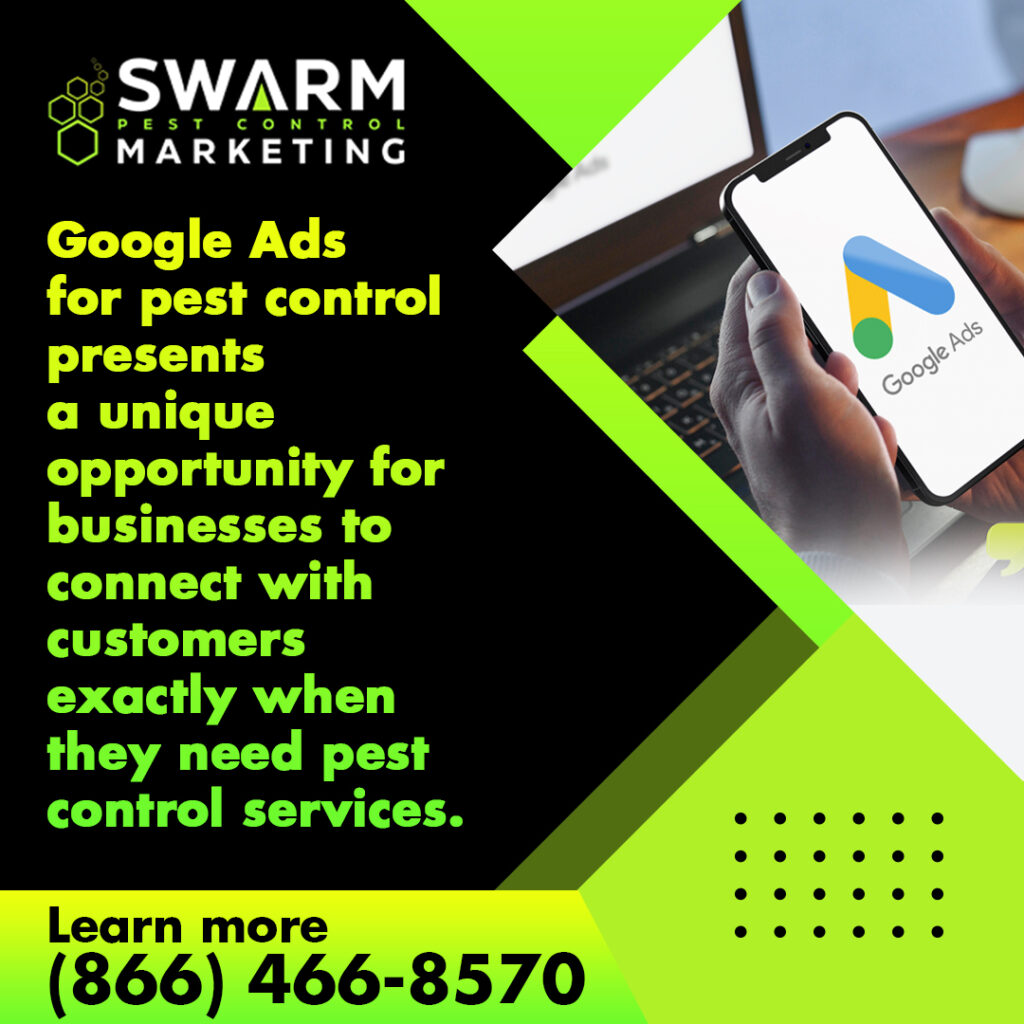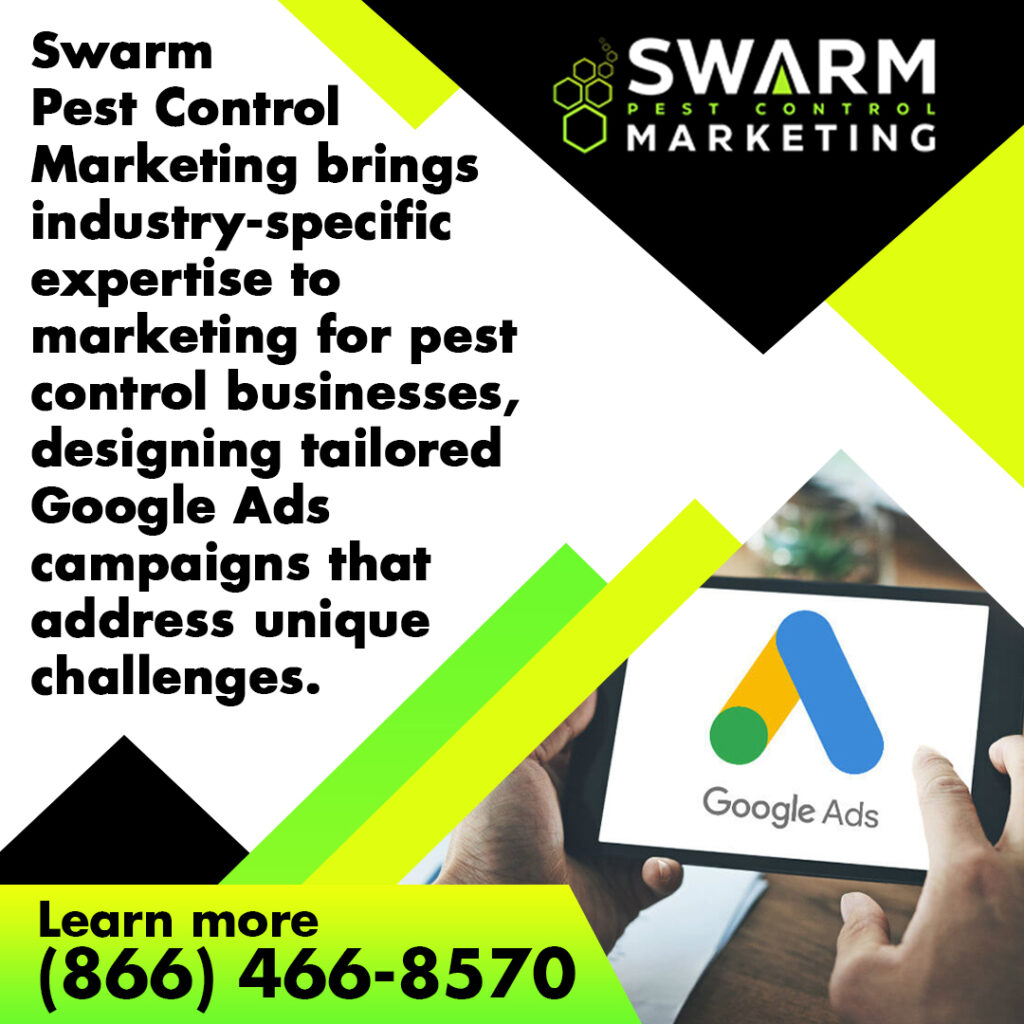
Maximize Your Pest Control Business Growth with Google Ads: A Complete Guide by Swarm Pest Control Marketing
Swarm Pest Control Marketing, based in Tucson, Arizona, specializes in delivering top-tier digital marketing strategies tailored for pest control businesses nationwide. Suppose you’re looking to attract more leads and gain visibility in a highly competitive industry. In that case, Google Ads for pest control is a powerful tool that can considerably boost your online presence. As experts in pest control digital marketing, we know the unique challenges pest control companies face in trying to stand out. Whether you’re a new business or looking to improve your existing campaigns, this guide will help you navigate the world of Google Ads, offering proven tactics and strategies that align with marketing for pest control needs. From setting up your campaigns to targeting the right audience, we’ll cover the essentials of web design for pest control, optimizing ads for conversions, and how to track and refine your approach. By the end of this guide, you’ll have actionable insights to create Google Ads campaigns that work hard for your business, driving the leads and growth you need to thrive in the pest control market.
The Evolving Role of Google Ads in the Pest Control Industry
As a pest control business, you likely understand that consumer search behavior has shifted considerably in recent years. People are no longer relying on traditional forms of advertising like print or cold calls to find pest control services. Instead, they turn to search engines, typing in specific queries to find solutions to their pest problems.
This change in behavior has made digital marketing, especially Google ads for pest control, more important than ever. Google Ads allows you to reach consumers when they are most likely to convert—when they are actively searching for pest control services in your area. The power of intent-driven advertising lies in its ability to match your services with the exact needs of a potential customer at the moment they need it most.
In the past, you may have relied on flyers, billboards, or newspaper ads to attract customers. While these strategies can still have their place, they no longer provide the same level of targeted reach that digital marketing for pest control can offer. Traditional ads blast messages to a broad audience, but Google Ads target individuals who are already interested in what you offer.

Google Ads not only boosts your visibility but also improves the quality of leads you receive. Google Ads targets users based on the search terms they use, meaning they already have a need for your services. This intent-driven advertising results in higher-quality leads that are more likely to convert into paying customers.
For example, someone searching for “exterminator near me” or “termite control services” has already expressed interest in those services. When your Google Ads appear in those search results, you’re directly engaging with individuals who are actively seeking help. As a result, these users are far more likely to call your business for a consultation or schedule an appointment, making your advertising spend much more efficiently.
At Swarm Pest Control Marketing, we specialize in web design for pest control and pest control digital marketing that drives meaningful results. Our team understands the evolving nature of consumer behavior and is here to help your pest control business adapt and succeed. By focusing on intent-driven advertising through Google Ads, we can help you target the right customers at the right time and make sure that your marketing dollars are spent efficiently.
The Science Behind Google Ads – How It Works for Pest Control Businesses
Understanding Search Intent and Ad Relevance
When running Google Ads for pest control businesses, it’s critical to understand search intent. Consumers who are actively searching for pest control services are generally in urgent need of assistance, whether to deal with an infestation or prevent one. This search behavior makes them valuable leads, as they are more likely to convert into customers.
The key to successful advertising lies in distinguishing between high-intent and low-intent searches. High-intent searches occur when someone is ready to take action, such as “pest control near me” or “exterminator in Tucson.” These are customers who are likely to hire a pest control service immediately. Low-intent searches, such as “how to prevent ants” or “types of pests in Arizona,” might indicate someone looking for information but not yet ready to make a purchase.
For your ad to perform well, it needs to align closely with the search intent. This means that the ad copy should directly speak to the user’s needs. If someone is searching for a specific pest control service, like “bed bug exterminator,” your ad should clearly reflect that service to capture their attention. By matching the ad with the user’s intent, you increase the likelihood of getting valuable clicks, ultimately driving conversions and enhancing your campaign’s overall success.
The Auction System – How Google Decides When Your Ad Shows Up
The process of getting your ad displayed on Google is based on an auction system that considers several factors. Businesses place bids for ad space on specific search terms, and Google decides which ads to show based on a combination of factors.
One of the key factors is the bid amount — the maximum amount you are willing to pay for each click on your ad. Higher bids generally increase your chances of securing a better position on the search results page.
Another critical factor is Quality Score, which Google assigns based on the relevance of your ad to the user’s search, as well as the quality of your landing page and the overall user experience. If your ad aligns well with the search intent and the landing page delivers on the promises made in the ad, you’ll likely receive a higher Quality Score. A high-Quality Score can result in better placement, even if your bid isn’t the highest.
These two elements—bid amount and Quality Score—combine to form the Ad Rank, which determines where your ad will appear on the search results page. Ads with a higher Ad Rank are shown more prominently, increasing their chances of attracting valuable clicks. The auction system guarantees that users see the most relevant ads, improving their search experience while helping businesses like yours connect with the right audience.
Breaking Down the Google Ads Algorithm for Pest Control Leads
Google Ads relies heavily on machine learning to optimize campaigns over time. As your ad continues to run, Google’s system learns which types of searches lead to the highest number of conversions. It then adjusts the delivery of your ad to prioritize these search terms, ensuring that your budget is spent more efficiently.
The relevance of your ad plays a major role in this process. When your ad is closely aligned with what the user is searching for, it’s more likely to be shown to a broader audience. Additionally, the system rewards ads that perform well. For example, if users click on your ad, visit your website, and engage with your content, the algorithm recognizes this positive interaction and increases the chances of your ad being shown to similar users.
Finally, the historical performance of your ads influences future outcomes. If your ads have a strong track record of driving leads, Google’s algorithm will favor your ads in future auctions. This is particularly important for pest control marketing, as past success helps establish trust with the system, leading to increased visibility and more opportunities to generate quality leads.
At Swarm Pest Control Marketing, based in Tucson, Arizona, we specialize in fine-tuning these factors to help pest control businesses get the most out of their Google Ads campaigns. By aligning ad relevance with search intent, optimizing bid strategies, and ensuring a seamless user experience, we can maximize the potential of your campaigns and drive higher-quality leads.
Crafting High-Performance Google Ads Campaigns for Pest Control
The Anatomy of a Winning Pest Control Ad
When it comes to pest control digital marketing, creating a click-worthy Google Ad is vital for driving high-quality leads to your pest control business. To truly stand out, your ad must resonate with homeowners facing pest issues. Crafting a message that speaks to their needs and concerns is important for success.
A successful ad begins with a strong headline that immediately grabs attention. For example, “Fast Pest Control Service – Available Now” or “Get Rid of Pests Today” directly addresses urgent needs. Offering same-day service or a guaranteed pest-free home taps into the emotions of fear and frustration, driving users to act quickly.
Psychological triggers are a powerful tool in marketing for pest control. Homeowners dealing with a pest problem are often motivated by urgency. Incorporating messaging like “Immediate Service” or “Protect Your Home” pushes the decision-making process.
In addition to strong messaging, web design for pest control plays an important role in making your ads effective. The landing page linked to your ad should be clear, simple, and easy to navigate, with a direct path for users to request a service. This seamless experience will improve your ad’s overall performance.
Targeting Strategies That Go Beyond Keywords
In digital marketing, targeting goes beyond just selecting the right keywords. Advanced targeting strategies are necessary to improve the success of your Google Ads campaign for pest control.
Using affinity audiences is one way to reach homeowners who are most likely to need pest control services. These audiences are identified by their behaviors, interests, or life stages. For example, targeting people who have recently bought a home in a pest-prone area can be an effective strategy. These people are more likely to need pest control services, and your ad will have a higher chance of converting.
Custom intent targeting is another pest control marketing idea that guarantees your ads appear when potential customers are actively searching for pest control solutions. By analyzing their search history and online behaviors, Google helps place your ad in front of individuals who are most likely to need your services soon.
In addition, competitor conquesting is a powerful strategy in pest control marketing ideas. By bidding on competitor keywords, you can target individuals who are searching for other pest control services. When your ad appears as a competitor alternative, especially if you offer something unique or better, such as a lower price or quicker service, it can lead to a higher conversion rate.
Crafting a Call-to-Action That Converts
Call-to-action (CTA) is a key component of any digital marketing campaign, particularly in the pest control industry. Your CTA should make it clear to potential customers what action you want them to take and why they should act now.
For emergency pest control, the CTA needs to create urgency. Phrases like “Call Now for Immediate Help” or “Same-Day Service Available” emphasize speed and address the homeowner’s immediate needs.
For preventive pest control services, the CTA can focus more on peace of mind. For example, “Schedule Your Annual Inspection Today” or “Protect Your Home Year-Round” encourages homeowners to act without the immediate pressure of an active pest issue. The goal here is to attract customers who are planning and looking for long-term pest protection.
By pairing an effective CTA with a well-designed ad and the right targeting strategies, you can considerably increase the performance of your Google Ads campaigns. This will help attract high-value leads, maximize conversions, and generate steady revenue for your pest control business.

How Swarm Pest Control Marketing Elevates Your Google Ads Success
Industry-Specific Google Ads Expertise
At Swarm Pest Control Marketing, based in Tucson, Arizona, we specialize in pest control digital marketing, offering a level of expertise that sets us apart from generic agencies. When you work with a pest control-focused agency, you’re tapping into a team that understands the nuances of your industry.
Our deep understanding of marketing for pest control allows us to craft compelling ads that resonate with homeowners who need pest control services. By focusing on the unique concerns and seasonal trends in pest control, we can effectively target the right audience at the right time. Our strategies are specifically designed to maximize your return on investment and deliver high-quality leads.
At Swarm, we also combine our expertise in web design for pest control with Google Ads to make sure that your ad landing pages are optimized for conversions. Every element of your campaign is fine-tuned to drive results, whether it’s through tailored ad copy, local SEO, or custom landing page designs that resonate with your audience.
Custom Campaign Strategies for Pest Control Businesses
A successful Google Ads campaign is about more than just choosing the right keywords; it’s about understanding pest control marketing ideas and how to apply them strategically throughout the year. Swarm Pest Control Marketing creates custom campaigns that reflect the seasonal nature of pest control services.
We also make sure your campaigns are highly localized, targeting homeowners in your specific service areas. This local targeting increases the likelihood of conversions by showing your ads to people who are ready to act and are within proximity to your business.
By understanding the unique needs of pest control businesses, Swarm’s pest control digital marketing strategies go beyond keywords. We leverage custom intent targeting to identify high-value leads, ensuring that every dollar you spend on Google Ads works hard to bring in relevant, high-quality traffic.
Full-Service PPC Management with a Data-Driven Approach
Effective PPC management for pest control businesses requires constant adjustment and optimization. Swarm takes a data-driven approach to ascertain that your campaigns are continually performing at their best. We track key metrics such as conversion rates and lead quality to make sure that you’re not only attracting traffic but also attracting the right kind of traffic.
With advanced conversion tracking, we analyze how your leads interact with your website after clicking on your ad. By understanding user behavior, we can refine your ad strategies to make sure you’re capturing the highest-quality leads possible.
The data-driven optimization process is key to keeping your Google Ads campaigns running efficiently and delivering results over time. By constantly refining and improving the performance of your campaigns, we can guarantee that your pest control business continues to thrive.
Dedicated Support and Long-Term Growth Planning
Swarm Pest Control Marketing isn’t just here for a one-time Google Ads campaign—we’re invested in your long-term success. Our personalized account management guarantees that you always have a dedicated professional overseeing your campaign, making adjustments to meet both your short-term goals and long-term growth objectives.
Through our pest control digital marketing expertise, Swarm focuses on helping your business build a strong foundation for sustained success. By combining tailored Google Ads strategies, localized targeting, and data-driven insights, we guarantee that your pest control business gets the attention it deserves, now and in the future.
Ready to Boost Your Pest Control Business with Targeted Google Ads?
At Swarm Pest Control Marketing, we know how to create Google Ads strategies that deliver real results for pest control companies. If you’re ready to leverage digital marketing for pest control and boost your online presence, we’re here to help. Contact us today at (866) 466-8570 to start building a custom Google Ads campaign that drives high-quality leads and growth for your business. Let’s work together to bring your pest control services to the top of search results!
digital marketing, pest control digital marketing, pest control marketing idea